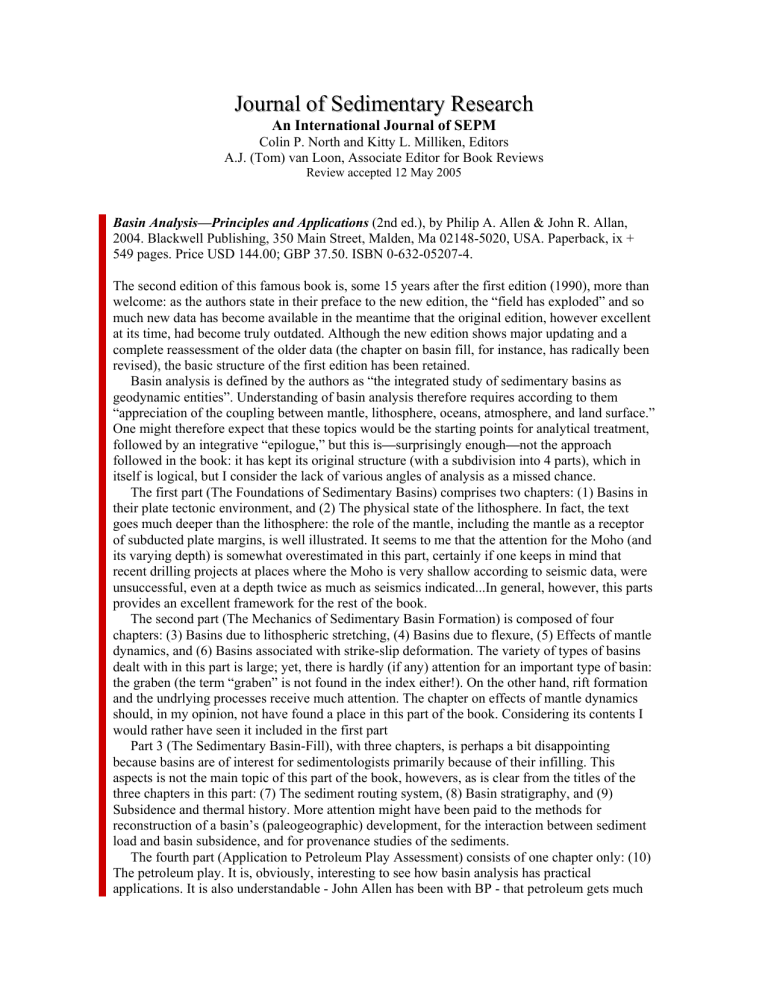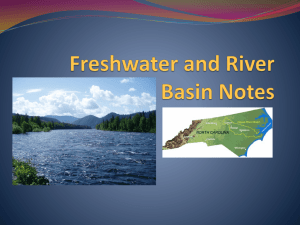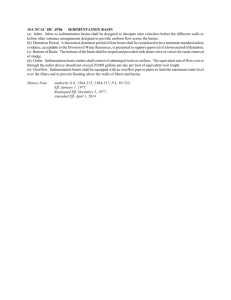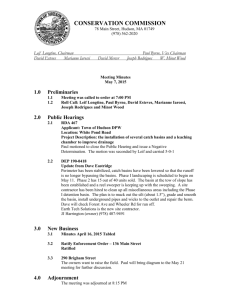Basin Analysis—Principles and Applications

J J o u r r n a l l o f f S e d i i m e n t t a r r y R e s s e e a r r c h
An International Journal of SEPM
Colin P. North and Kitty L. Milliken, Editors
A.J. (Tom) van Loon, Associate Editor for Book Reviews
Review accepted 12 May 2005
Basin Analysis—Principles and Applications (2nd ed.), by Philip A. Allen & John R. Allan,
2004. Blackwell Publishing, 350 Main Street, Malden, Ma 02148-5020, USA. Paperback, ix +
549 pages. Price USD 144.00; GBP 37.50. ISBN 0-632-05207-4.
The second edition of this famous book is, some 15 years after the first edition (1990), more than welcome: as the authors state in their preface to the new edition, the “field has exploded” and so much new data has become available in the meantime that the original edition, however excellent at its time, had become truly outdated. Although the new edition shows major updating and a complete reassessment of the older data (the chapter on basin fill, for instance, has radically been revised), the basic structure of the first edition has been retained.
Basin analysis is defined by the authors as “the integrated study of sedimentary basins as geodynamic entities”. Understanding of basin analysis therefore requires according to them
“appreciation of the coupling between mantle, lithosphere, oceans, atmosphere, and land surface.”
One might therefore expect that these topics would be the starting points for analytical treatment, followed by an integrative “epilogue,” but this is — surprisingly enough — not the approach followed in the book: it has kept its original structure (with a subdivision into 4 parts), which in itself is logical, but I consider the lack of various angles of analysis as a missed chance.
The first part (The Foundations of Sedimentary Basins) comprises two chapters: (1) Basins in their plate tectonic environment, and (2) The physical state of the lithosphere. In fact, the text goes much deeper than the lithosphere: the role of the mantle, including the mantle as a receptor of subducted plate margins, is well illustrated. It seems to me that the attention for the Moho (and its varying depth) is somewhat overestimated in this part, certainly if one keeps in mind that recent drilling projects at places where the Moho is very shallow according to seismic data, were unsuccessful, even at a depth twice as much as seismics indicated...In general, however, this parts provides an excellent framework for the rest of the book.
The second part (The Mechanics of Sedimentary Basin Formation) is composed of four chapters: (3) Basins due to lithospheric stretching, (4) Basins due to flexure, (5) Effects of mantle dynamics, and (6) Basins associated with strike-slip deformation. The variety of types of basins dealt with in this part is large; yet, there is hardly (if any) attention for an important type of basin: the graben (the term “graben” is not found in the index either!). On the other hand, rift formation and the undrlying processes receive much attention. The chapter on effects of mantle dynamics should, in my opinion, not have found a place in this part of the book. Considering its contents I would rather have seen it included in the first part
Part 3 (The Sedimentary Basin-Fill), with three chapters, is perhaps a bit disappointing because basins are of interest for sedimentologists primarily because of their infilling. This aspects is not the main topic of this part of the book, howevers, as is clear from the titles of the three chapters in this part: (7) The sediment routing system, (8) Basin stratigraphy, and (9)
Subsidence and thermal history. More attention might have been paid to the methods for reconstruction of a basin’s (paleogeographic) development, for the interaction between sediment load and basin subsidence, and for provenance studies of the sediments.
The fourth part (Application to Petroleum Play Assessment) consists of one chapter only: (10)
The petroleum play. It is, obviously, interesting to see how basin analysis has practical applications. It is also understandable - John Allen has been with BP - that petroleum gets much
attention. It seems to me, however, that the attention is somewhat overdone:this single chapter constitutes about a quarter of the entire book. This is the more remarkable, since coal basins — of at least equal economic and sedimentary significance — are hardly dealt with in the book: a few lines in this petroleum chapter only; browncoal/lignite can even not been found in the index.
Summarizing, the book contains a wealth of information, although the contents do not seem really in balance. Basin analysis is, in my opinion, particularly of interest for sedimentologists, but the book seems at least equally aimed at structural geologists. The main readership is meant to consist of advanced undergraduate students, but graduates and professionals will also find much valuable information. Particularly for the undergraduates two aspects are usefull: each chapter starts with a summary, and the book contains numerous boxed text (commonly with a mathematical character) that help to understand physical aspects. All readers will prifit from the well written text and from the figures that are, as a rule, clear and informative. One may wonder, however, why so many figures that would perfectly fit within one column, have been printed at a slightly larger size; much space (and thus also money) could have been saved by a somewhat smaller size that would also have resulted in a more attractive layout. Of course, some figures show omissions (where are the areas where weathering products go to, in Figure 7.2) or inaccuracies (the geoid height above the reference ellipsoid is not indicated in meters in Figure
2.24, as should be the case), but that can hardly be avoided in a work like this.
It is a pity that the publisher did not force the authors to adhere to the SI system. This results in figures where distances arein one place indicated in feet, and in other places in meters. It is also annoying that the abbreviation ‘yr’ is used througout the book where the letter ‘a’ (annum) is prescribed. Such small editorial mistakes could easily have been avoided. Nevertheless, the book should be welcomed by all those who carry out basin analysis, or who want to know how the results of basin analysis should be interpreted. The book will certainly be used frequently by those who want to pay the relatively high price; it is therefore unfortunate that the paperback edition does not give the impression that it will physically last for 15 years. Let’s therefore hope that the publishers and the authors already have decided for a third edition in a not to remote future. The authors may then prolonge the success that I expect for this second edition. And a third edition may be needed: as the authors state so well: ”the field [of basin analysis] has exploded”, and there is no reason to believe that this explosive development would not go on in the years to come.
A.J. van Loon
Faculty of Earth Sciences
University of Silesia
Sosnowiec, Poland t.vanloon@ultra.cto.us.edu.pl






